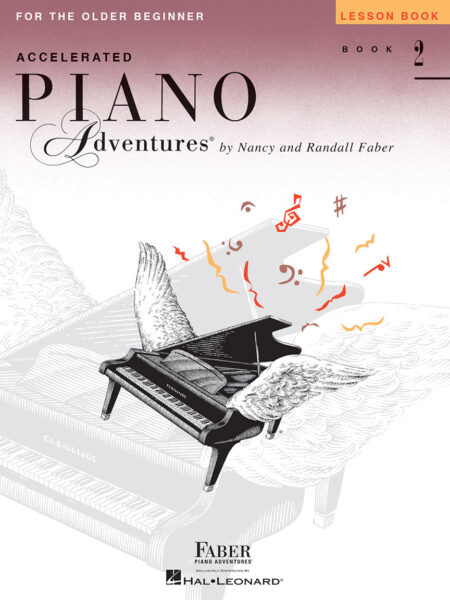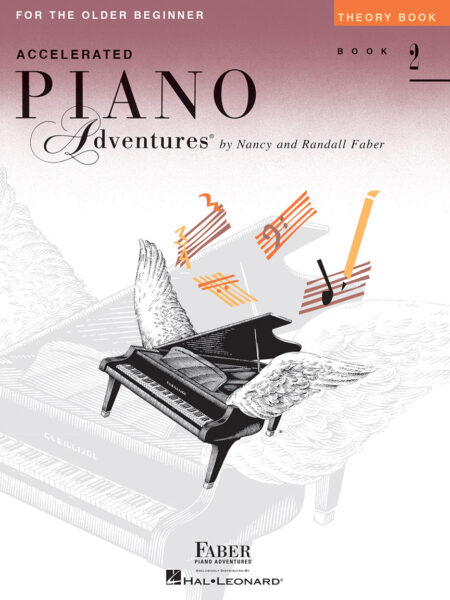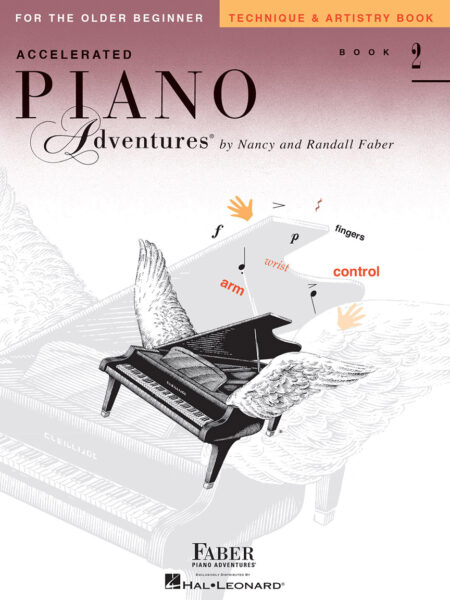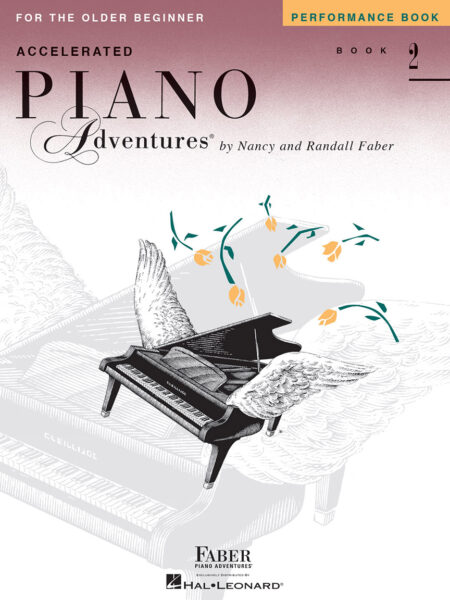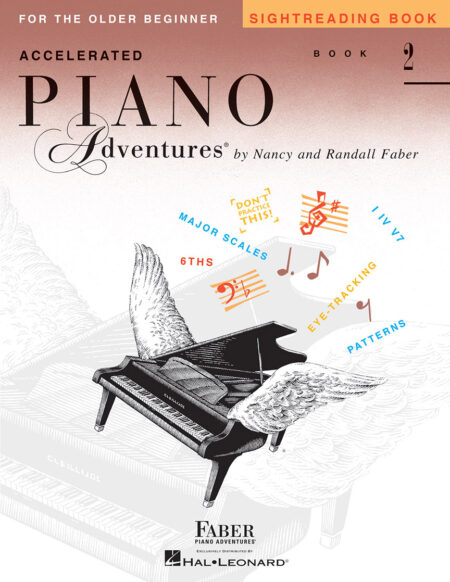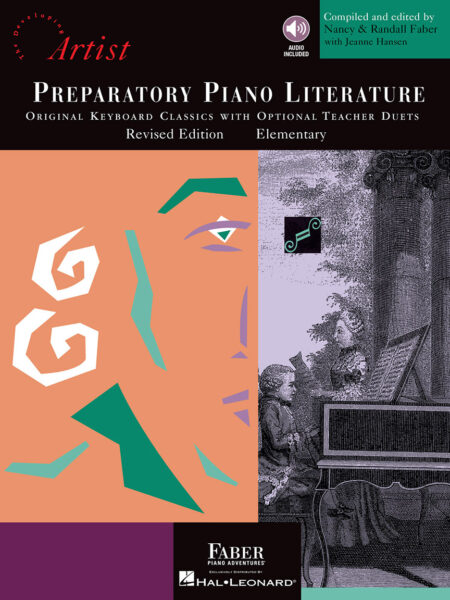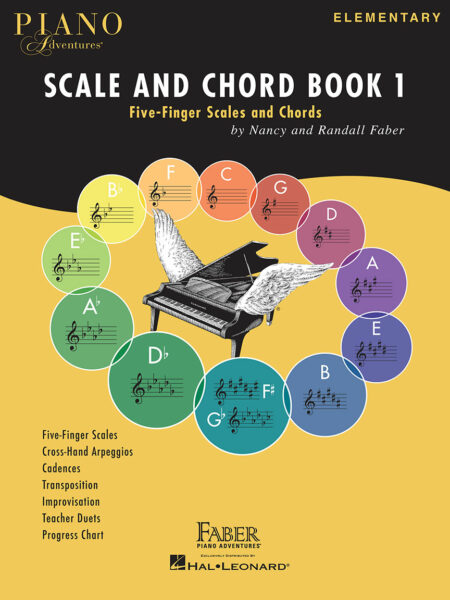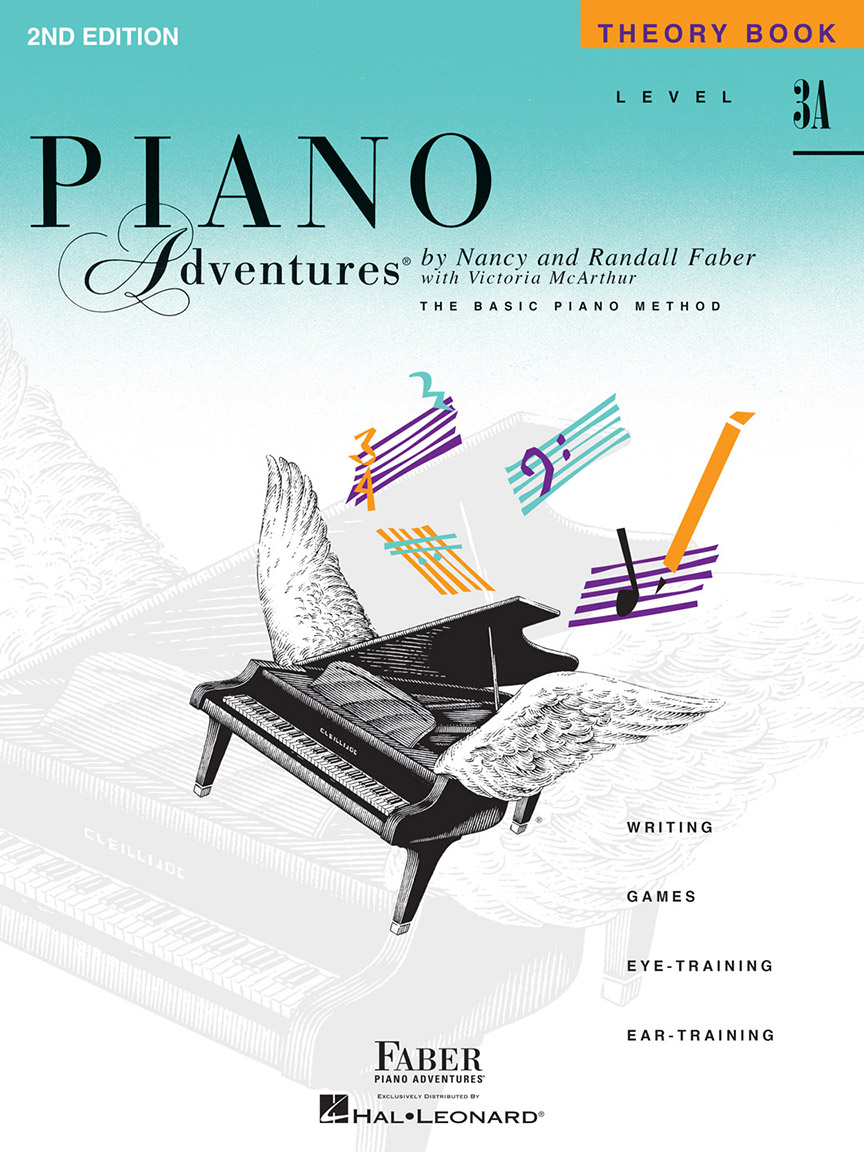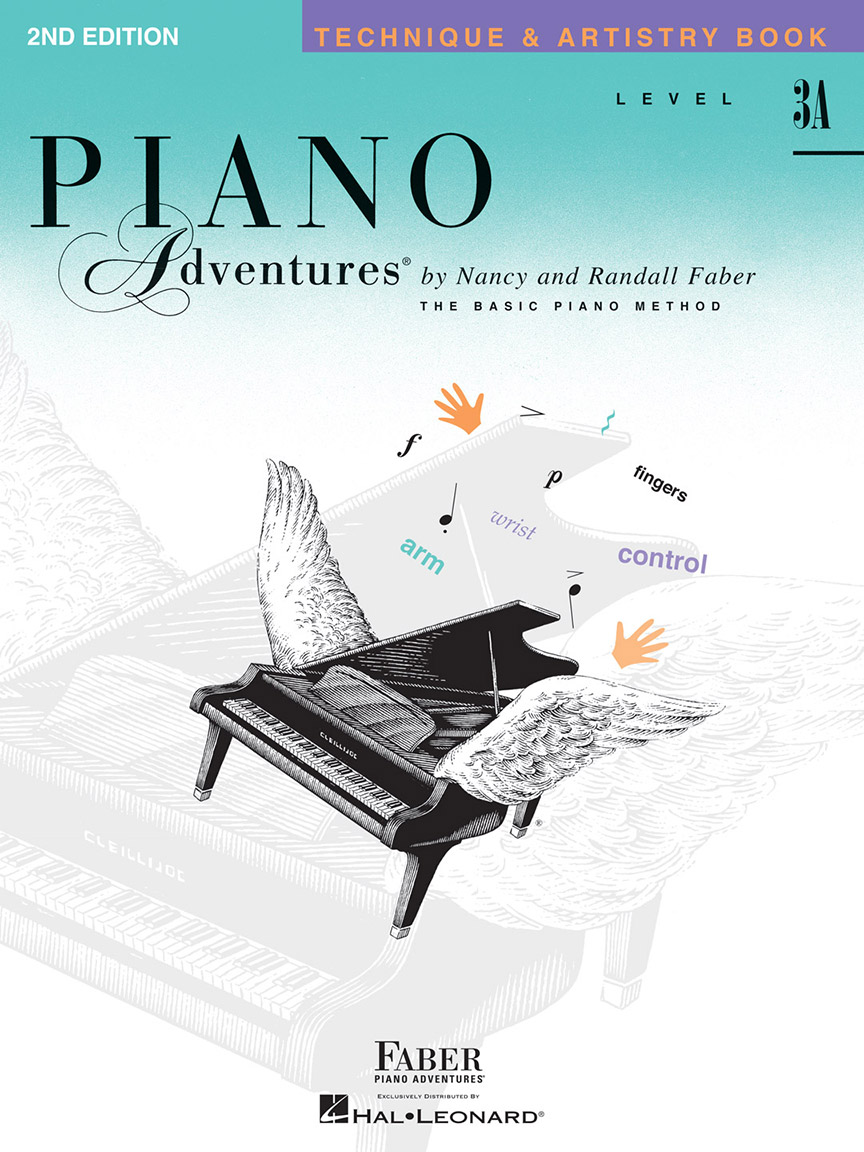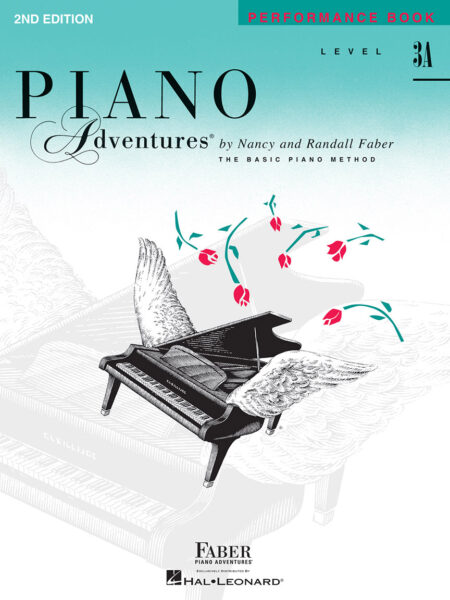
20Questions and Answers for Accelerated Book 2
About the Accelerated 2 Books
- Accelerated Lesson Book 2 starts with a “Music Review” of
Accelerated Level 1. Is this important to do? - Should I use all four core books: Lesson, Theory, Technique & Artistry, and Performance?
- How do I fit all four core books into a lesson?
- How are advancing rhythms taught in Accelerated 2 Books?
- How are outer ledger lines introduced and reinforced?
- How is transposition treated with the major scale and primary chords?
- How is the damper pedal used in Accelerated 2 Books?
- What are the Technique Secrets and how do they help?
- When should I use the Accelerated 2 Sightreading Book and how?
- Is it okay to add extra notes or chords to an arrangement if the student is able to do this?
About the Accelerated 2 Student
- How long should an Accelerated 2 student practice?
- How can my students best use the Scale and Chord “Reference Sections” in the Technique & Artistry Book 2?
- When can an Accelerated 2 student start playing classical music?
- Are there lead sheets in Accelerated 2 Books?
- How do Accelerated 2 students compose and improvise?
- What books can Accelerated 2 students play for extra fun?
- Should an Accelerated 2 student be in a scale book?
- Can I teach an Accelerated student online? What are some teaching tips?
- After Accelerated 2 Books, where should a student go?
About Accelerated 2 Audio Files
1. Accelerated Lesson Book 2 starts with a “Music Review” of concepts from Accelerated Level 1. Is this important to do?
Accelerated 2 Lesson Book opens with an Accelerated 1 Music Review. It’s a handy teacher assessment tool and can be used for students graduating to Accelerated Book 2 as well as transfer students. This Music Review helps the teacher assess what is understood and what needs more support.
The two pages cover rhythm, time signatures, intervals, C and G major 5-finger scales, sharp, flat, intervals, and many other symbols and terms.
Areas in which the student lacks confidence allow the teacher to “review and renew” understanding. Explore board work, flashcards, and cheerful questions and answers to review concepts together.
Accelerated 2 Lesson Book
Book 1 Music Review (pp. 4-5)

2. Should I use all four core books: Lesson, Theory, Technique & Artistry, and Performance?
The four core Accelerated 2 Books form a set for wholistic learning and correlate by page number. The Theory, Technique & Artistry, and Performance Books give fresh perspectives for concepts in the Accelerated 2 Lesson Book. It’s possible a teacher could substitute a different solo book than the Performance Book. However, the precise tie-in of concepts in the core books is hard to beat. The older beginner is forming connections—connections that form the “musical mind”—and the more efficient these connections are made the better.
The core books address things easy to miss in lessons; ear-training, sightreading, improvisation, and importantly, technique from the first lessons. Taking the time for deeper learning using the four core books prepares students for success in Level 3A of the Basic Method.
3. How do I fit all four core books into a lesson?
The three most important books are the Lesson Book 2, the Theory Book 2, and the Technique & Artistry Book 2. A 30-minute lesson allows about 10 minutes per book. A 45-minute lesson, recommended for the accelerated student, offers a time advantage for using all four books.
If time is short, consider demonstrating the Performance Book piece while the student watches the music. Give a few pointers, then assign to learn at home as an “independent study.” This gives the teacher an opportunity to see what is easy and what is challenging at the next lesson.
For the Theory Book, the teacher might review the first example on a page with the student, then assign to complete at home. With careful lesson planning and efficient use of lesson time, the four books can be implemented, even if one book is not covered in some lessons.
4. How are advancing rhythms taught in Accelerated 2?
In Accelerated 2 Books, 8th notes rhythms are now prevalent and blended into new concepts such as scale passages in different keys, as well as chordal rhythms using 8th notes.
The main advancing rhythm, however, is the eighth rest, single eighth note, and the dotted quarter note.
The eighth rest is introduced first with a rhythm exercise that prepares the piece, “Pumpkin Boogie.” This piece uses a catchy, repeating R.H. “vamp” with an eighth rest.
This leads to the presentation of the dotted quarter note. The opening example shows a quarter note tied to an eighth note. The tie is then replaced with the dot for the rhythm again. Two snippets of famous melodies follow where students naturally feel the rhythmic pattern: “Silent Night” and “Eine Kleine Nachtmusik.” Metric counting is included.
To cap off the presentation of the dotted quarter note, “Lazy Chord Blues” uses the primary chords in C to create a relaxed L.H. groove with a dotted quarter note pattern. The R.H. plays a simple bluesy tune above. From there the dotted quarter appears in increasing sophisticated settings.
Accelerated 2 Lesson Book
Pumpkin Boogie (eighth rest, pp. 68-69)

Famous Melody Examples (dotted quarter note, p. 70)
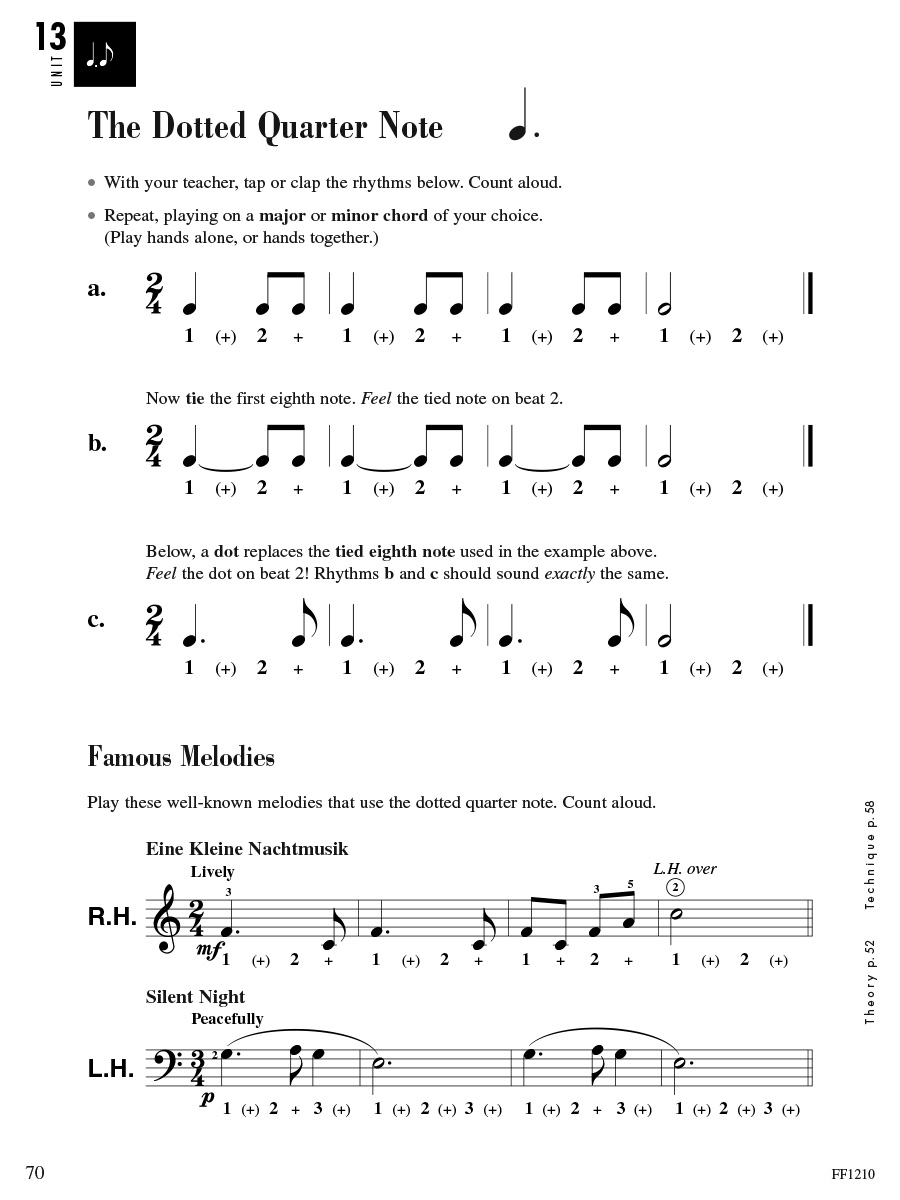
Lazy Chord Blues (dotted quarter note, p.71)


5. How are outer ledger lines introduced and reinforced?
Unit 1 opens with “The Family of C’s”—5 different C’s across the Grand Staff. The ledger line notes introduced are Low C, two ledger lines below the bass staff and High C, two ledger lines above the treble staff.
Low C and High C expand the landscape of the Grand Staff. Students make graceful gestures outward to these notes. Or, in a faster tempo, explore quick lateral shifts.
Ledger line C’s appear throughout the level in ostinato passages, color tones, cross-hand arpeggios, and accented bass notes, to name a few.
More outer ledger notes are introduced in Level 3A.
Accelerated 2 Lesson Book
5C’s (p. 40)
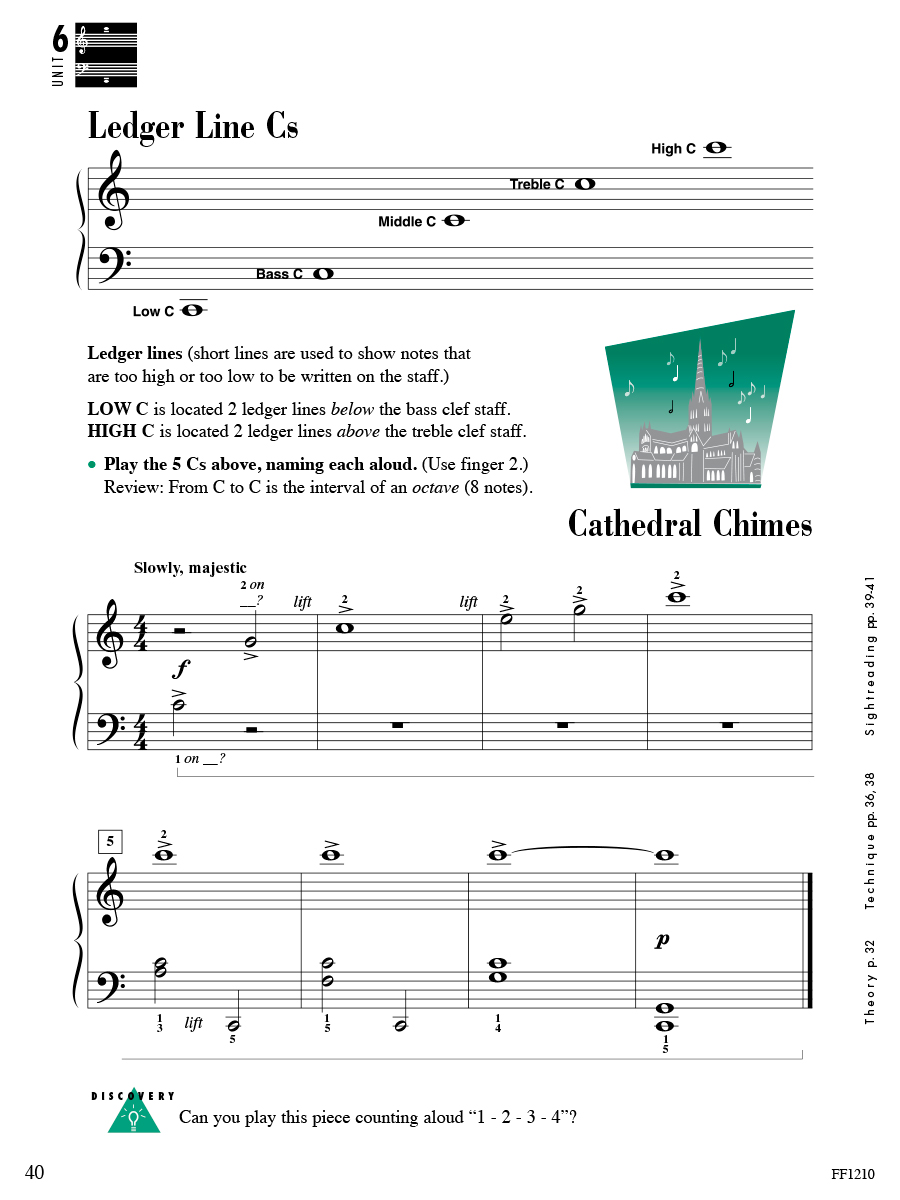
Sounds from the Gumdrop Factory (ostinato, p. 42)

Almost Like a Dream (color tones, p. 43)

Accelerated 2 Performance Book
The Time Machine (quick L.H. shifts, pp. 20-21)

6. How is transposition treated with the major scale and primary chords?
When the student begins transposing outside the 5-finger scale, transposition takes on new significance. Using the “ear,” thinking intervals, and relating tonic, dominant, and leading tone all build important theory skills.
Once the G major scale is learned, (pp. 76-77), transpose these G major pieces to the key of C major. And consider swinging back to earlier C major pieces and transpose these to G major. An entire song, or just a portion of a piece can be transposed. Students become “keyboard smart” with short transposition workouts.
See transposing ideas below.
Accelerated 2 Lesson Book
Minuet in G (transpose to C pp. 78-79)

French Dance (transpose to C, p.83)

Can-Can (transpose to G, pp. 56-57)

Rise and Shine (transpose to G, p.59)

7. How is the damper pedal used in Accelerated 2 Books?
Pedaling is used in three ways in the Accelerated 2 Books.
- For the entire piece for a sustained, impressionistic sound.
- For several measures for finesse and a polished sound.
- For “up-down” connected pedaling, coordinating eye, hand, and foot.
Accelerated 2 Lesson Book
Whirling Leaves (entire piece, pp. 16-17)

Cathedral Chimes (entire piece, p. 40)

Evening Guitars (measures or section, pp. 38-39)

America (measures or section, p.72)

Beach Party (connected pedaling, p.65)

Summer Stars (connected pedaling, pp. 86-87)


8. What are the Technique Secrets and how do they help?
Technique at the piano requires more than finger muscles. It involves sophisticated body motion between the body, arm, wrist, and finger. We call these motions “technique gestures.”
At each level of Piano Adventures, the student is introduced to level-appropriate Technique Secrets that promote fluent playing while preventing bad habits. These “secrets” are used as daily warm-ups for the exercises that follow in the book. This combination of secrets and exercises leads to an Artistry Magic Piece at the end of each unit. These pieces allow the older beginner to demonstrate artistry based on fine technique learned earlier.
Accelerated 2 Technique & Artistry Book has 9 Technique Secrets, each with a unique name.
Part 1
- Firm Fingertips (Finger Inspector)
- Light Thumb (Light as a Feather)
- Wrist Float-off (Moon Walk)
- Fast Fingers (Flying Fingers)
Part 2
- Arm Weight (Heavy Arms)
- Slur Gesture (Painter’s Brush Stroke)
- Light Thumb on Scales (Weightless Thumb)
- Connected Pedaling (Pedal Pushers)
Check out book pages below.
Accelerated 2 Technique & Artistry Book
Book 2 Technique Secrets—Part One (pp. 4-5)

Book 2 Technique Secrets—Part Two (pp. 36-37)

Check out sample videos here.
9. When should I use the Accelerated 2 Sightreading Book and how?
The Accelerated 2 Sightreading Book builds confident readers in two ways: recognition of individual notes and perception of rhythmic and melodic patterns.
The book is organized into sets of 5 exercises, for 5 days of practice. Each set presents variations on a piece from the Accelerated 2 Lesson Book. Play one exercise a day, completing one set per week.
Students may begin the Accelerated Sightreading Book 2 with the second piece in the Accelerated Lesson Book 2, “Rustic Dance.”
Here are several ways to use the book.
- Teachers listen to the sightreading example for just “Day 1” at the lesson. Assign the next pages of the 5-day set to sightread at home. At the following lesson, the teacher might choose one sample “Day” from that set to hear. Then assign the next set.
- If teaching 30-minute lessons, teachers might consider using the Sightreading Book in place of the Performance Book.
- The Sightreading Book can be used as a final end-of-level project. Before starting Level 3A, take several weeks to assign multiple pages of the Accelerated 2 Sightreading Book, supported with a ChordTime Book. Students can enjoy a change of pace in their practice assignment, while celebrating their increasing reading expertise.
Accelerated 2 Sightreading Book
Table of Contents (pp. 2-3)

How to Use (pp. 4-5)
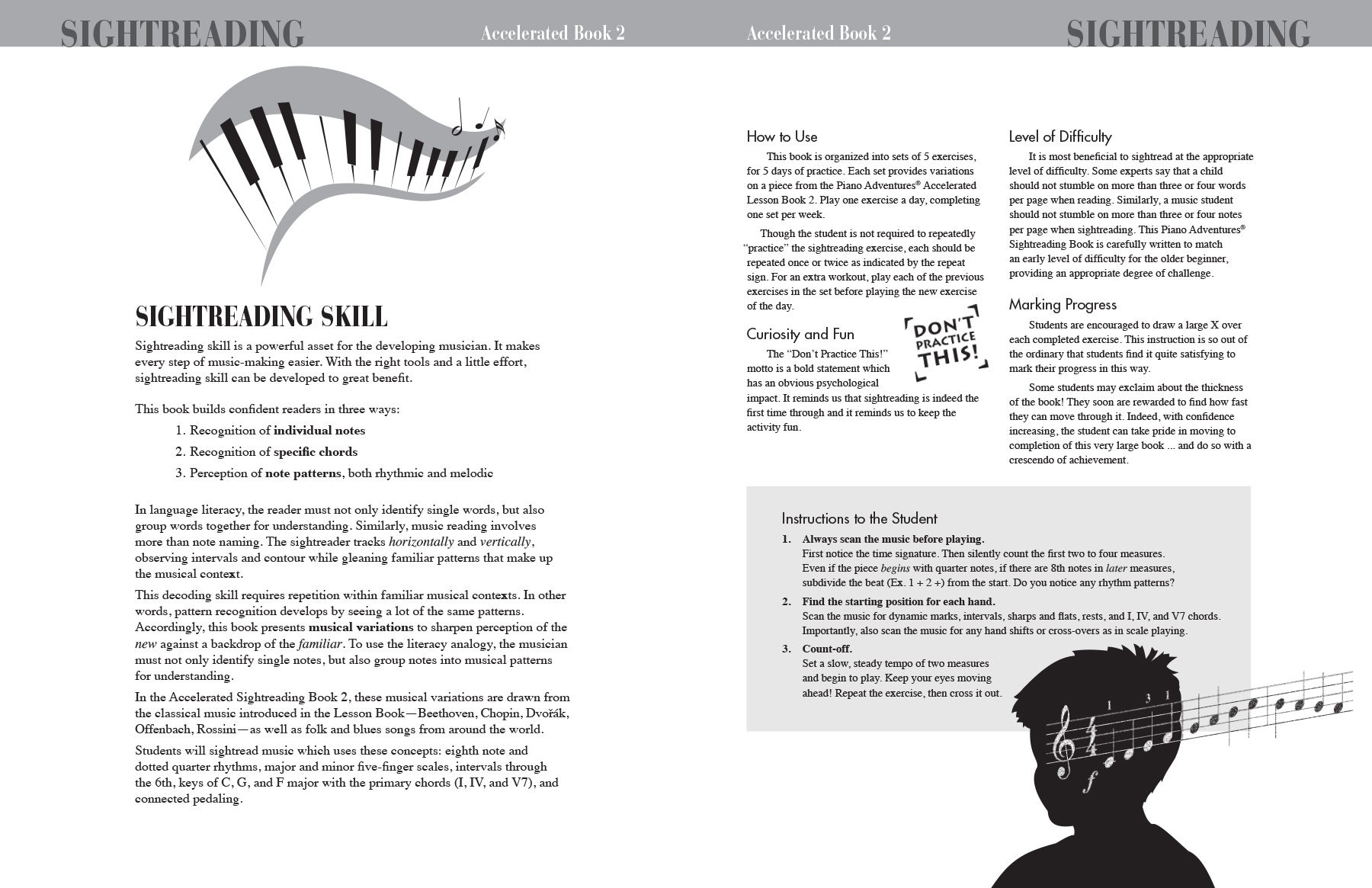
Jumpin’ Jazz Cat Set (pp. 51-53)


10. Is it okay to add extra notes or chords to an arrangement if the student is able to do this?
Yes, feel free to do so!
- Add more chords (or a simple LH 5th) in certain measures.
- Create an Introduction and Ending.
For example, in the key of C, begin by playing a cross-hand arpeggio on G (dominant) from low to very high on the keyboard. Then start the piece. At the end, play a final cross-hand arpeggio on C (tonic). - Create an extended ending by playing the last line an octave higher.
- Explore different dynamics and write them in the music.
Have a little adventure. Add your own touch to the song!

About the Accelerated 2 Student
11. How long should an Accelerated 2 student practice?
Ideally, a student should be practicing 30 minutes a day. 40-45 minutes a day would be terrific! You may have heard the witty piano slogan, “The best players are on the bench.” The accelerated student can easily understand this wisdom.
A practice assignment can include as many pieces as possible for that unique individual, theory page(s), and Technique & Artistry exercises. The Performance Book and/or Sightreading Book can keep reading skills sharp!
As part of the practice plan, consider having review pieces or “just for fun” pieces. These allow the student to bring a piece to a higher level of performance. The teacher can assign songs to be memorized to develop this skill.
Other motivational repertoire, such as the ChordTime Piano Books are addressed in Question 17.
12. How can my students best use the Scale and Chord “Reference Sections” in the Technique & Artistry Book 2?
Resource Section 1 presents all the 12 major and minor 5-finger scales. Each has a keyboard with steps marked W-W-H-W (major) or W-H-W-W (minor).
A student could easily begin Reference Section 1 in Unit 2 (D, A, E) and Unit 4 (Cm, Gm, Fm). Gradually learning the 12 keys is essential for good musicianship. Practice variations could include: scales with hands one-octave apart, hands two-octaves apart, a crescendo ascending and a diminuendo descending, and staccato-legato combinations.
At the end of the book, Reference Section 2 presents the 12 major I-V7 chords, the 12 minor i-V7 chords, and concludes with the 12 major I-IV chords. Teachers can present these gradually. Or, as the student arrives at the end of the book, learn the chords as a prerequisite for beginning Level 3A. Students might enjoy a ChordTime Piano Book for several weeks while bringing these important theory and technique basics into their fingers.
Accelerated 2 Technique & Artistry Book
Reference Section 1: Major 5-Finger Scales (pp. 30-33)


Reference Section 1: Minor 5-Finger Scales (pp. 34-35)

Reference Section 2: Major I and V7 Chords (pp. 68-69)

Reference Section 2: Minor i and V7 Chords (p. 70)
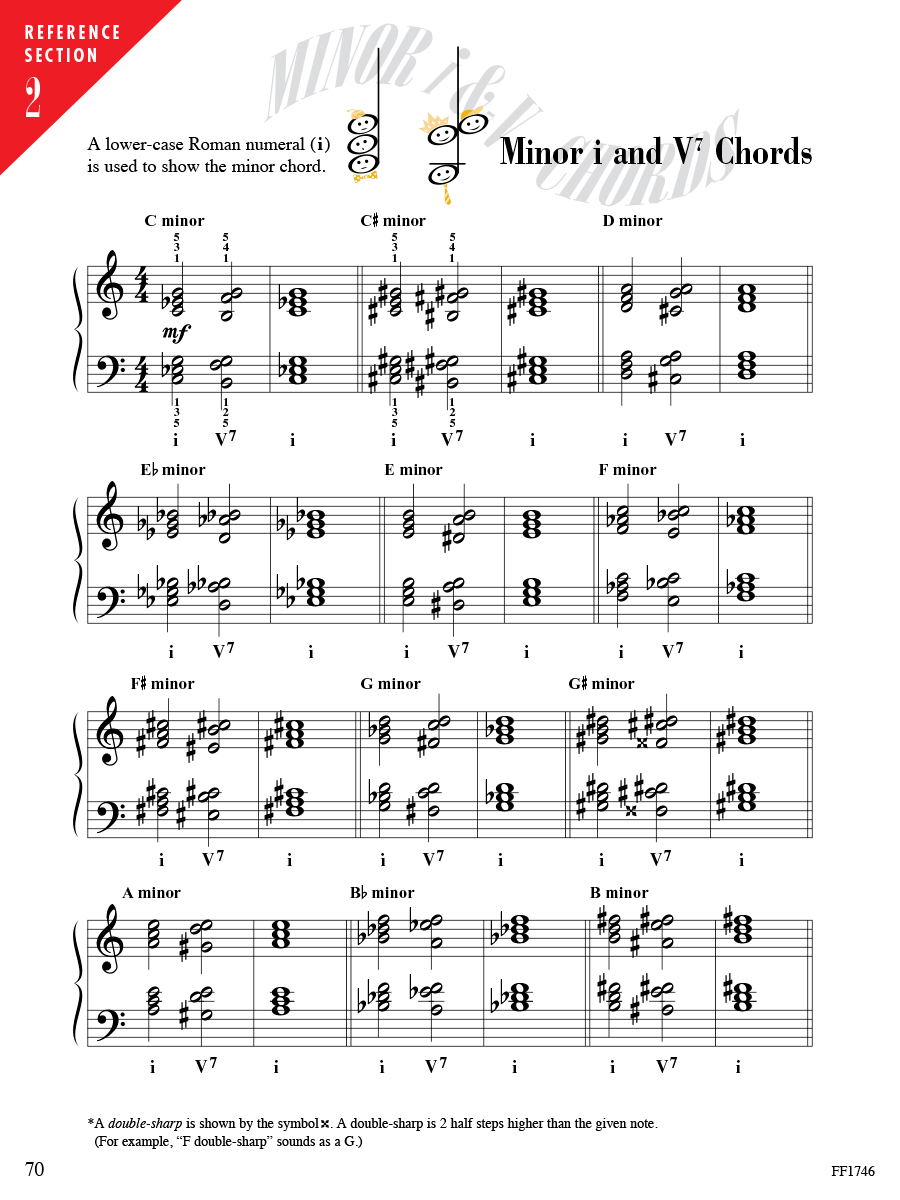
Reference Section 2: Major I and IV Chords (p. 71)
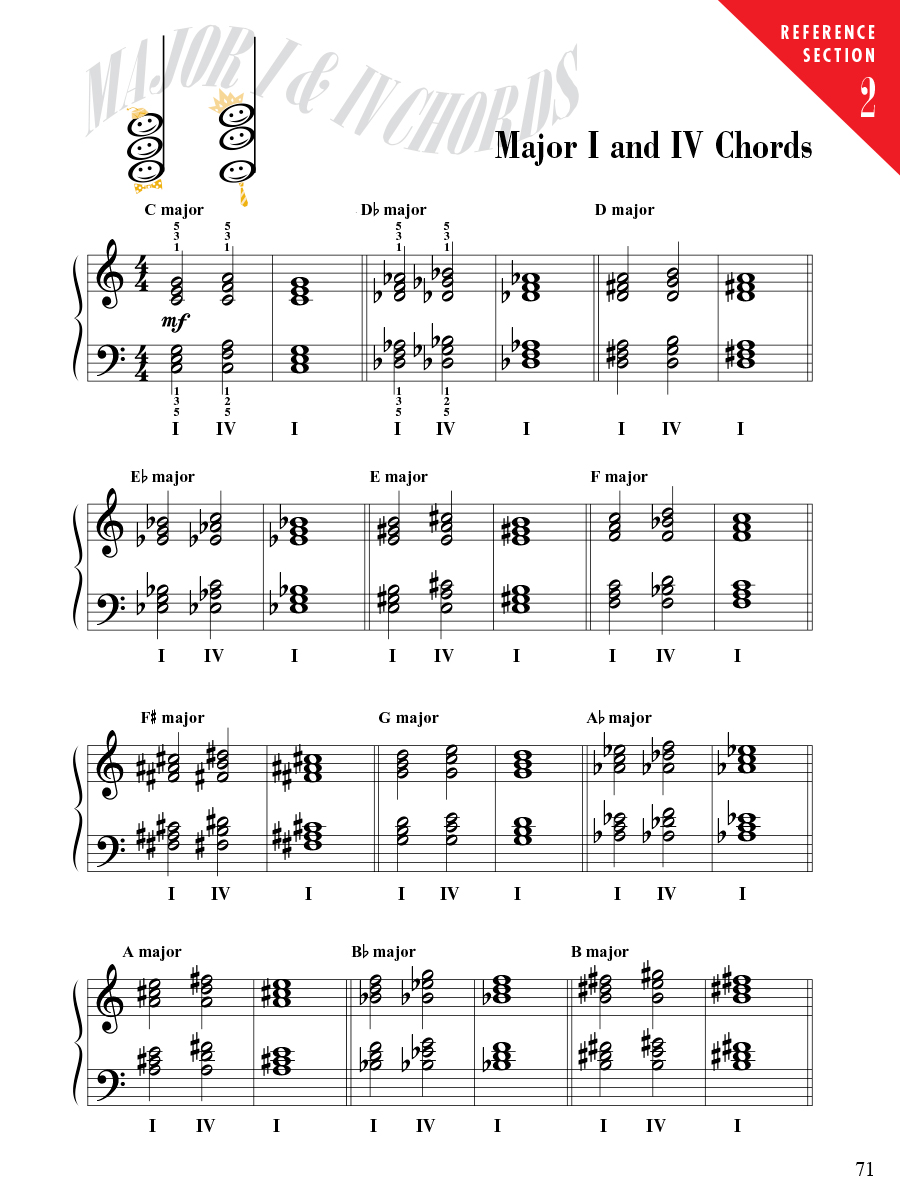
13. When can an Accelerated 2 student start playing classical music?
An older beginner in Accelerated Lesson Book 2 could begin Preparatory Piano Literature in UNIT 6 with the presentation of minor pentascales. The “Prep Lit’s” independence of the hands and suggestions for transposition (at the bottom of the page) offer a great review while delving into classical music.
Preparatory Piano Literature
Table of Contents (p. 3)
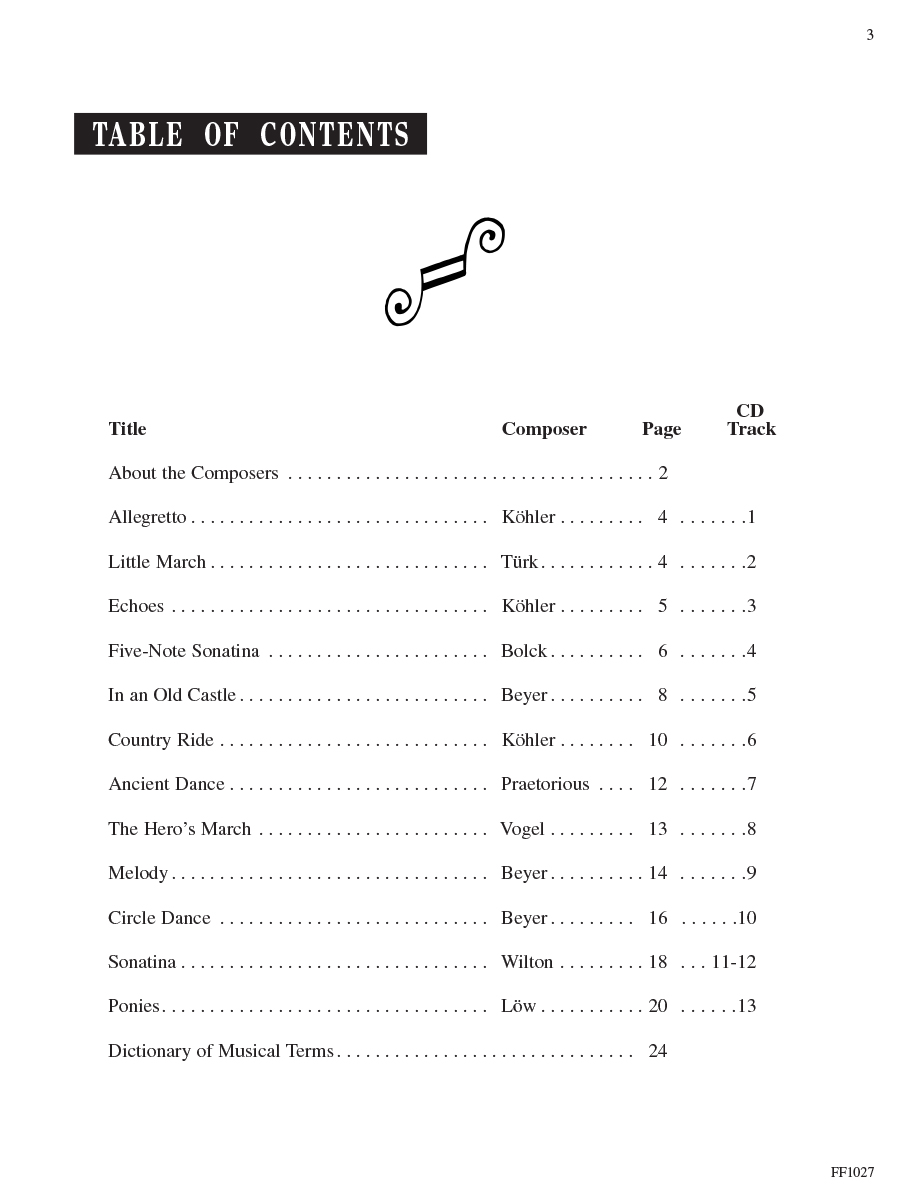
Allegretto, Little March (p. 4)

Melody (pp. 14-15)

14. Are there lead sheets in Accelerated 2 Books?
There are five lead sheets in the Accelerated 2 Theory Book. The lead sheets feature various keys, major and minor chords, and show accompaniment patterns for students to explore.
Lead sheets are one of the best ways ever to actively apply the theory of chords and be able to play many more pieces!
Accelerated 2 Theory Book
Hey, Ho, Nobody Home (4/4, Dm, pp. 28-29)

Home on the Range (3/4, C, pp. 46-47)

Greensleeves (3/4, Am, pp. 52-53)

For He’s a Jolly Good Fellow (3/4, G, p. 58)

Londonderry Air (4/4, F, p. 62)
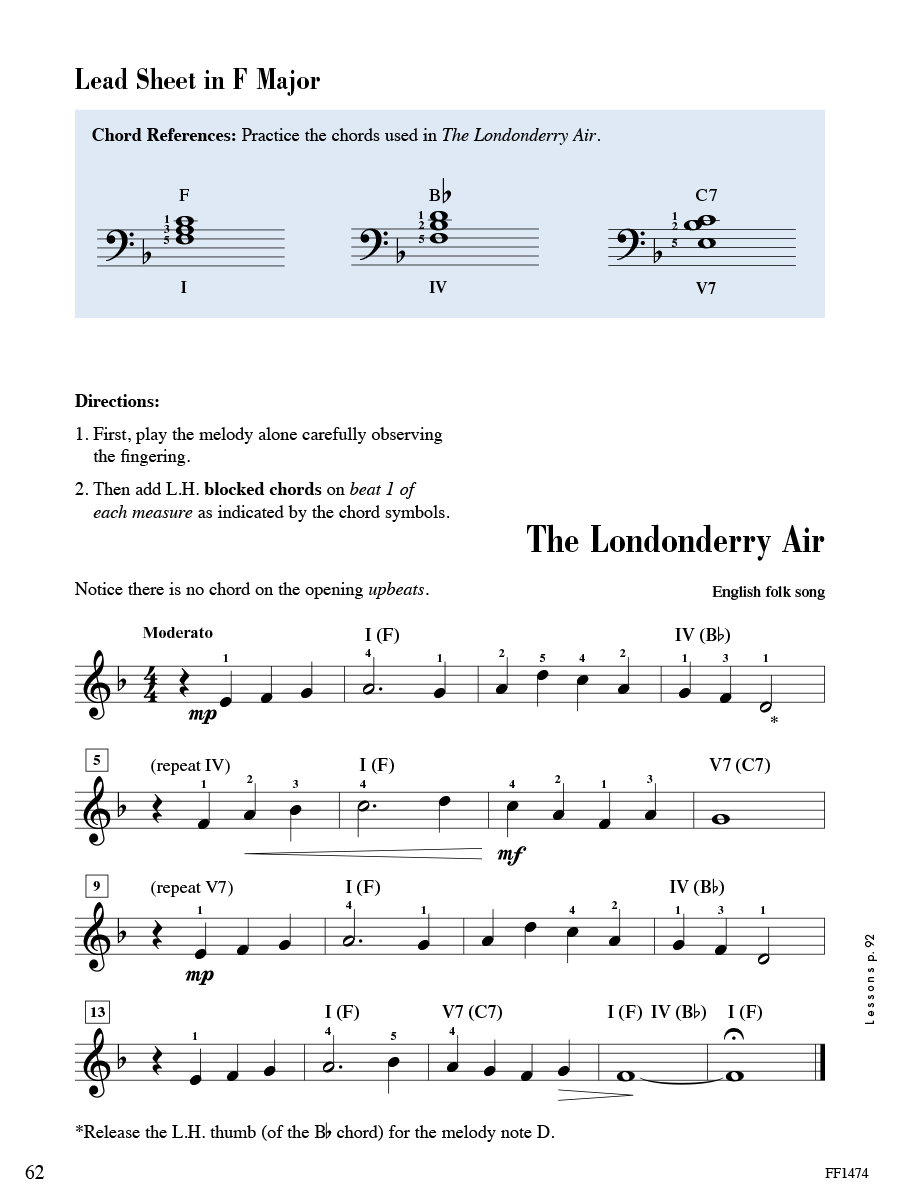
15. How do Accelerated 2 students compose and improvise?
There are many opportunities to compose and improvise in the Accelerated 2 Theory Book. These activities are integrated throughout the level and offer support to new concepts.
Accelerated 2 Theory Book
Students create a bell song using the 7 Guide Notes and pedal.
Guide Note Bells (p. 2)

Students improvise with half and whole steps over Teacher Duets.
Improvisation with Half and Whole Steps (p. 9)

Students compose Questions and Answers in minor keys.
Questions and Answers in Minor Pentascales (p. 21)

Students write their own rhythm in various time signatures.
Create Your Own Casbah Rhythm (p. 23)

16. What books can Accelerated 2 students play for extra fun?
For extra Accelerated 2 fun, ChordTime Piano Books offer a variety of styles with many familiar songs. The name “ChordTime” suggests exactly that—to play chords!

ChordTime Books support 3 musical outcomes:
- To bring C, G, and F scales and I, IV, V7 chords into a student’s “toolkit.”
- To recognize I, IV, V7 blocked and broken chords, waltz chords, etc.
- To play these chords with confidence in different musical styles.
Accelerated 2 Lesson Book
I, IV, and V7 chords are presented at these points:
Chord Jumps, Rise and Shine (key of C primary chords, pp. 58-59)

Chord Jumps, French Dance (key of G primary chords, pp. 82-83)

Playing the F Major Scale (key of F primary chords, p. 89)
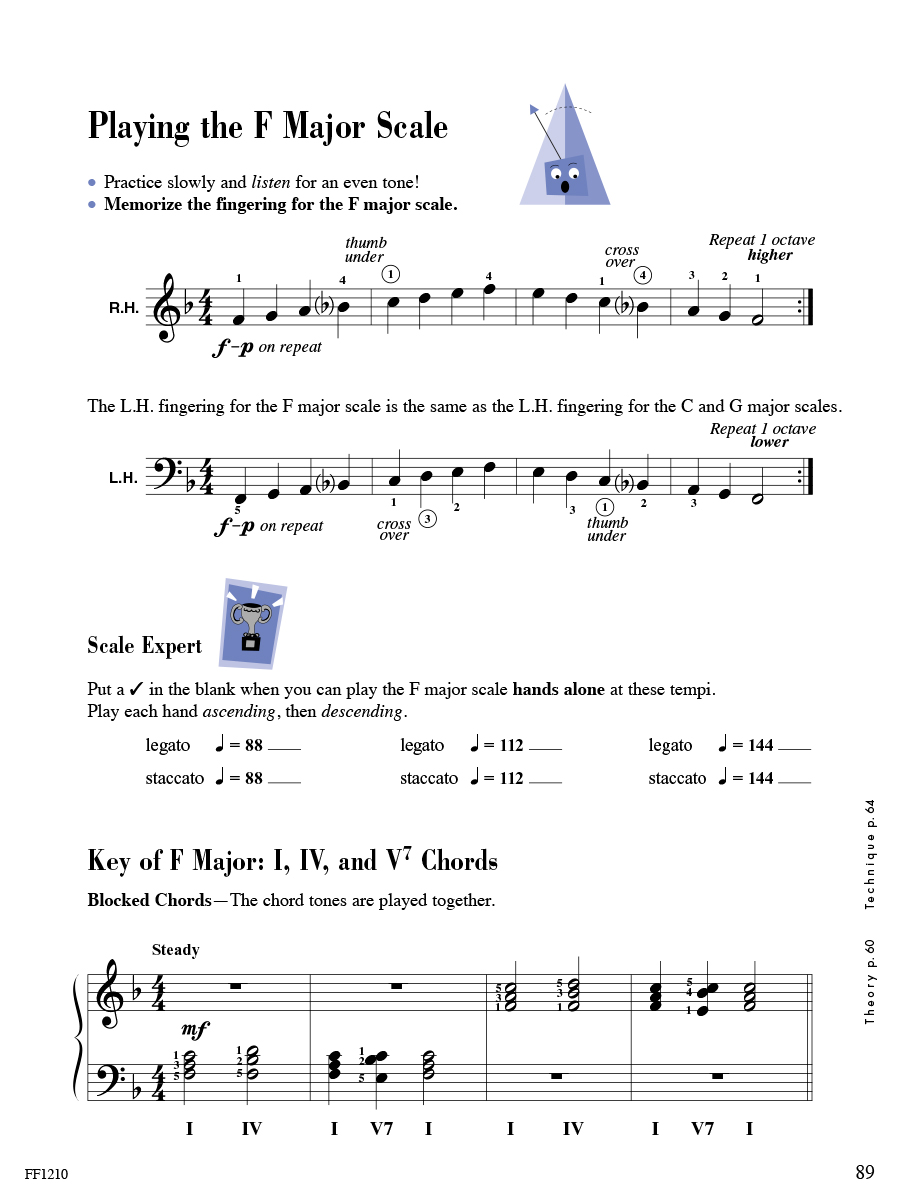
17. Should an Accelerated 2 student be in a scale book?
To explore 5-finger technique with scale exercises and improvisations, the teacher can consider the Piano Adventures Scale and Chord Book 1. It should be noted that the major and minor pentascales are already included in the Reference Section of the Accelerated 2 Technique & Artistry Book. It is the improvisations and cross-hand major and minor arpeggios that give it distinction.
Piano Adventures Scale and Chord Book 1
Major 5-Finger Scales (p. 8)
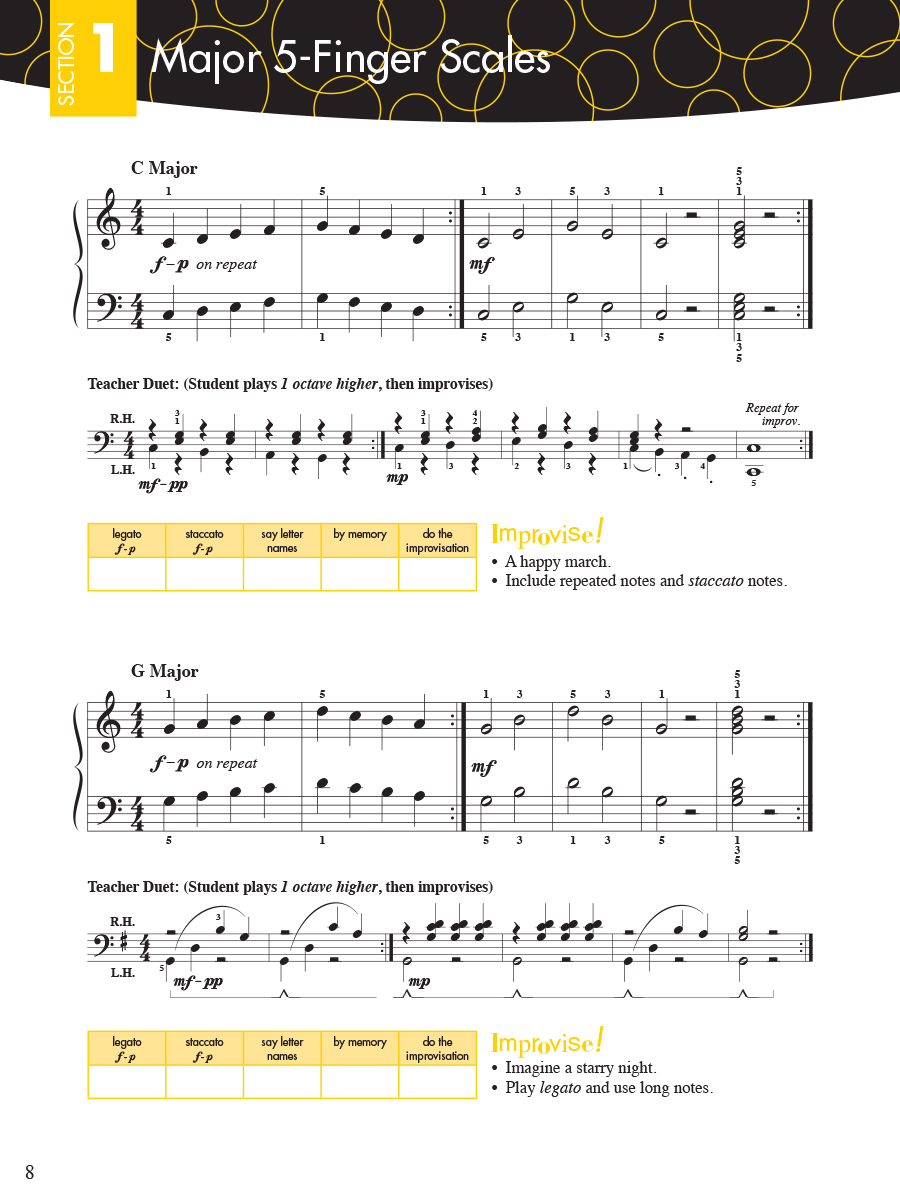
Major Cross-Hand Arpeggios (p. 16)
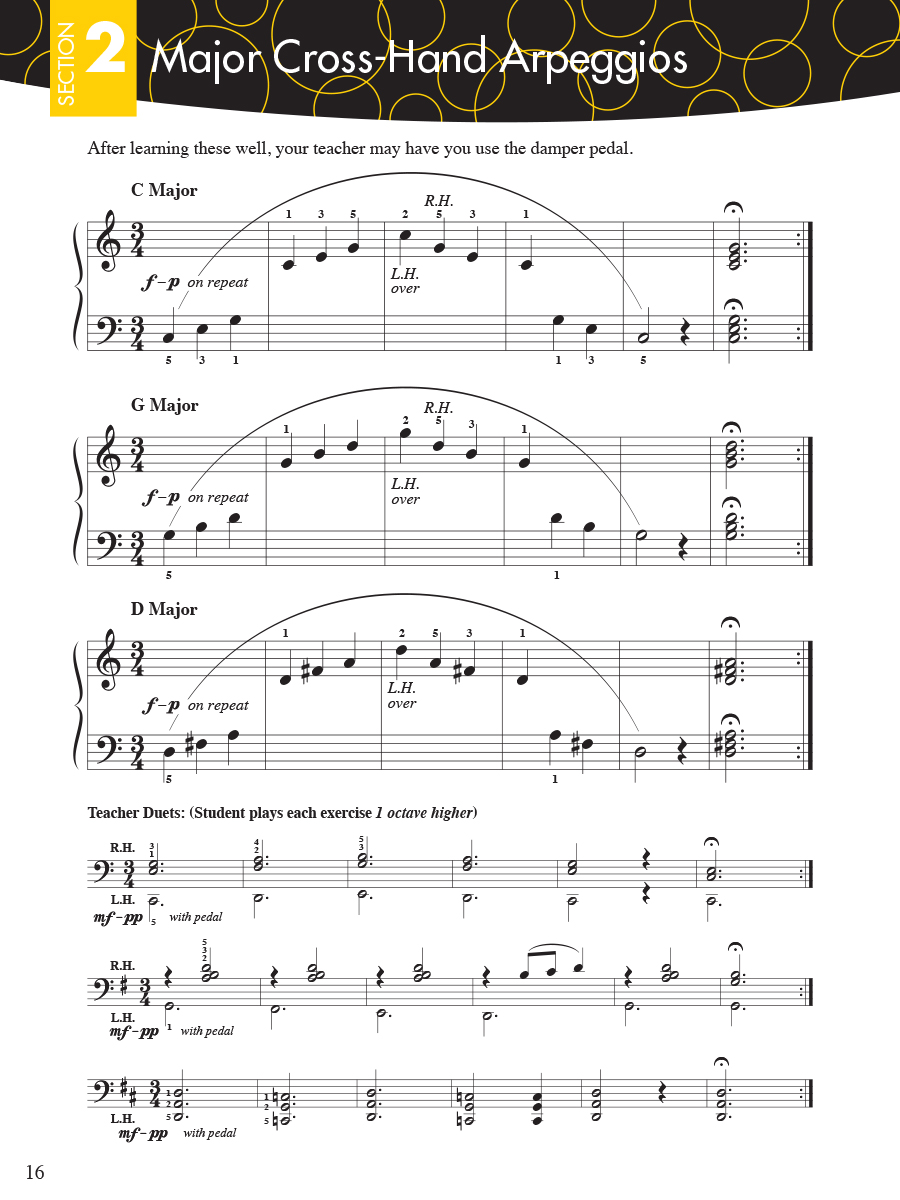
Minor 5-Finger Scales (p. 23)
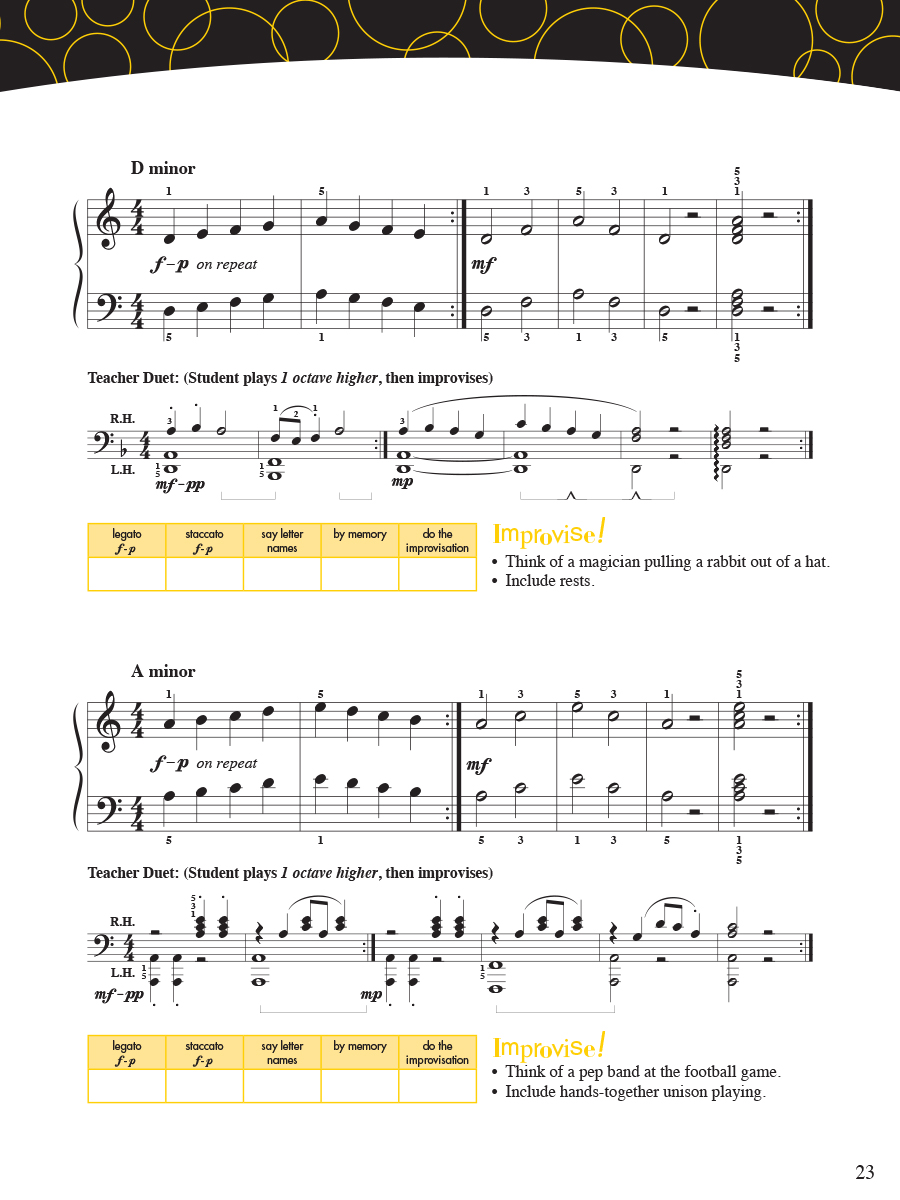
Minor Cross-Hand Arpeggios (p. 31)
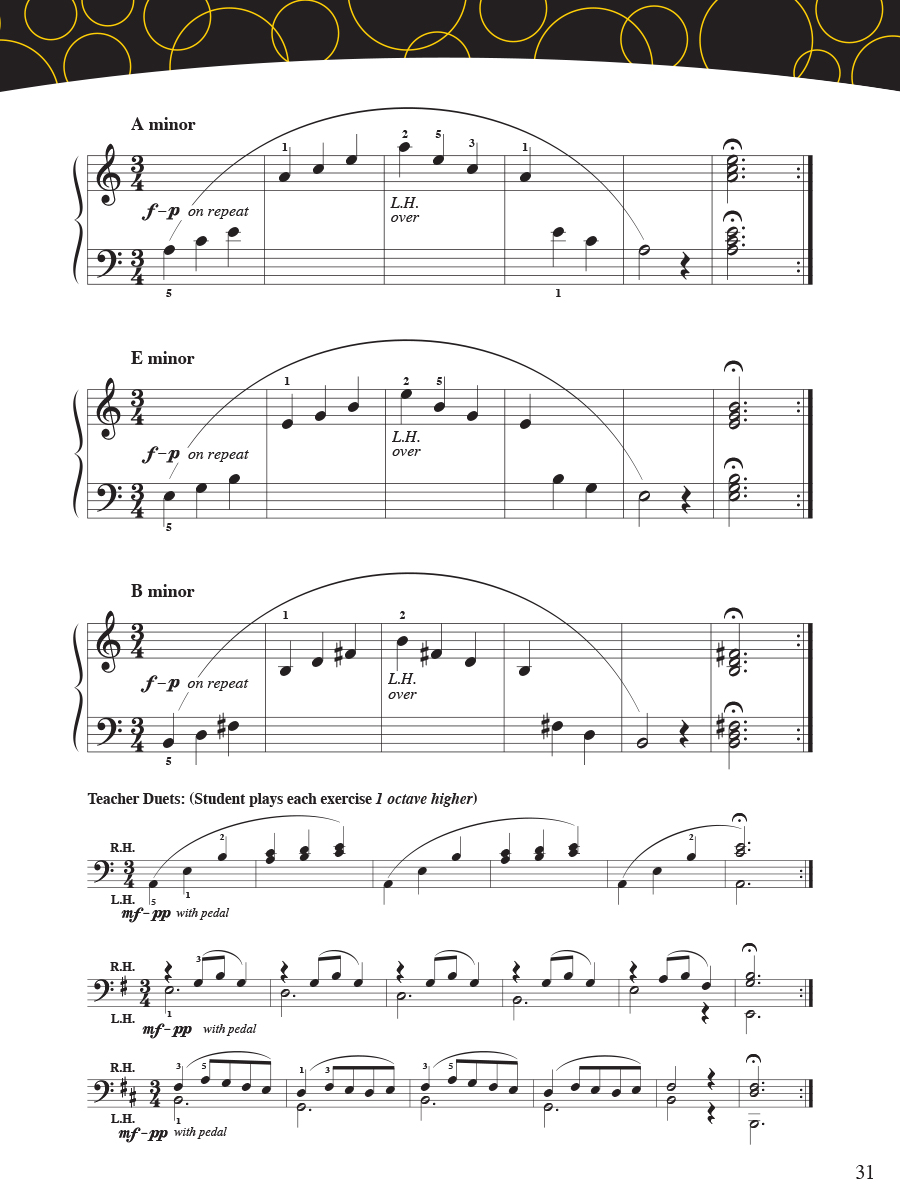
18. Can I teach an Accelerated student online? What are some teaching tips?
Yes, it is completely possible to teach the core Accelerated 2 Books in an online lesson, such as Zoom.
The best way to do this is through subscribing to the Teacher Atlas and using its screen-sharing capability. All books in the Faber Library are available for viewing and screen sharing—including the Accelerated 2 Books, Scale and Chord Book 1, and the supplementary ChordTime Books.
Here are some ideas for teaching the Lesson Book in an online lesson.
NOTE: Have the student become very familiar with the music before playing. Accomplish this through questions that require active responses from the student. Keep the discussion light, upbeat, and “congratulatory” as the student answers.
Let’s apply this to the UNIT 6 piece, “Jumpin’ Jazz Cat.” These are sample ideas. Teachers can create original questions and responses.
Accelerated 2 Lesson Book
Jumpin’ Jazz Cat (pp. 54-55)

Sample Online Questions for “Jumpin Cat Cat”
- Let’s begin “Jumpin’ Jazz Cat” by listening to the orchestration and following the music—to get the flavor of the piece. There’s one thing to check out first.
Look at the bottom of page 2 and you’ll see a text box that says, “Da Capo al Fine.” Can you say that?
“Yes, Da Capo al Fine.” - When we see “Da Capo al Fine” we return to the beginning and play to the “Fine.” Let’s see if we can see the word Fine in the music. It’s rather small and in italic. (Move cursor from the beginning to m. 8) Do you see it there?
“Great. That’s where the piece will end.” - Let’s also read the purple box at the top of the first page. Can you read that aloud for us? (Student reads)
“Thank you!”
Notice the text said, “almost always ends on C, the tonic. Let’s return to the our “Fine” (move cursor). Look at the last R.H. note. Is it a C?
Yes, it is. And the L.H. plays a C chord.” - Okay, now the orchestration! Follow the cursor moving the notes. (Play)
- Now look at m. 1. Is the scale descending (going down) or ascending (going up)?
“Right, descending.” - Now listen as I play m. 2. Then you can imitate me. (Do)
“Good work.”
Here it is again. (Do) Can you play it 3 times in a row by yourself?
“Nice, well done!” - Let’s turn our attention to m. 9 on page 2? What’s the dynamic mark?
“Right, mp. So, we begin rather softly. - Tell me, does that note begin on the tonic or the dominant?
“Yes, Bass G, the dominant.” - I’m going to play the scale going up… (Do)…and then my pinky just lands on Bass C to complete the pattern. (Do)
“Your turn. Good! Two more times to really get the feel of it.” - Are you ready to try the entire piece? Let’s include the D.C al Fine.”
“Excellent. Have fun with that this week! Towards the end of the week, try it a little faster but still keeping in all the dynamics. Very good focus.”
19. After Accelerated 2, where should a student go?
After completion of the Accelerated 2 Books, students may graduate to Level 3A in the Basic Method. This level continues with the four core books: Lesson, Theory, Technique & Artistry, and Performance. Other support books of interest are the Sightreading Book, Popular Repertoire Book, and Christmas Book.
The level in the PreTime to BigTime Piano Library that corresponds to Level 3A is called FunTime Piano. It too has a variety of styles to match the student’s interest.
About Accelerated 2 Audio Files
20. What are the audio files and how could I use them?
Orchestrated accompaniments for Accelerated 2 Books pieces are available in the Audio Cloud and Piano Adventures Player app. Have fun exploring with your students!
Preview a track a week before teaching it at the lesson. As you listen together, discuss the sound. Is the piece cheerful or sad? Is the tempo fast or slow? Can you name one of the instruments that is playing?
Playing with a background accompaniment demands correct rhythm, and can be more fun than using a metronome. Students learn to feel the meter and understand the need to “keep going.” Demonstrate with the practice tempo track and point to each note in time, or chant the lyrics, finger numbers, or note names.
Many of the accompaniments encourage free improvisation on the black or white keys. These extra measures offer opportunities to create original sounds.
The musical vignettes in this series introduce the student to a variety of musical sounds and ensembles, such as the marching band, chamber orchestra, jazz ensemble, rock band, and more.


